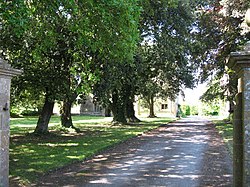Clifton Maybank
| Clifton Maybank | |
| Dorset | |
|---|---|
 Clifton Maybank House | |
| Location | |
| Grid reference: | ST577138 |
| Location: | 50°55’20"N, 2°36’13"W |
| Data | |
| Population: | 40 (est.) |
| Post town: | Yeovil |
| Postcode: | BA22 |
| Dialling code: | 01935 |
| Local Government | |
| Council: | Dorset |
| Parliamentary constituency: |
West Dorset |
Clifton Maybank is a hamlet in Dorset. It is located about a mile south-west of the village of Bradford Abbas. The main sight of the village is its manor-house, Clifton Maybank House, a country house with surviving Tudor fabric.
An estimate of the population of the parish in 2013 was 40.
History
Clifton Maybank is recorded in the Domesday Book as Clistone, held by William Malbank, a tenant of Hugh, Earl of Chester in 1086,[1] and it is from Malbank that the 'Maybank' suffix derives.[2] Clifton Maybank is also mentioned in the Anglo-Saxon Chronicle of 1001.@@@[3]
Writing in 1811, Samuel Lewis stated that the village had 60 inhabitants and that the church at Clifton Maybank had "been in ruins for a century".[4]
Clifton Maybank GWR railway station
On 13 June 1864 a new line was opened from the GWR Wilts, Somerset and Weymouth line up to a new Clifton Maybank goods station located on the south side of the LSWR Yeovil Junction railway station. The GWR was, until 1874, a 7 foot broad gauge line and broad and standard gauge wagons could be brought alongside each other at Clifton Maybank to allow goods to be transhipped between them.
The transfer shed used for transhipping goods and approximately ¼ mile of track along the Clifton Maybank spur are now part of the Yeovil Railway Centre, where steam trains named the Clifton Maybank Rambler are being run in 2019.
Clifton Maybank House
The early history of Clifton Maybank (sometimes named Clifton Maubank or Clifton House) is obscure. The Horsey family of Horsey near Bridgwater in Somerset held properties in and around Clifton Maybank during the fifteenth century.[5] When John Horsey (1479–1531) died, he was buried at Yetminster parish church, near Clifton Maybank. His son, Sir John Horsey substantially increased the family's wealth and power. Little is known of the Horsey family house at Clifton Maybank at this time, but it is known that the poet Sir Thomas Wyatt died while staying at the house in 1542.[6] Sir John died four years later in 1546.
Soon after this, his eldest son, Sir John Horsey, made Clifton Maybank his principal residence and began a major and expensive rebuilding[5][7] process on the house, using the local Ham stone. It has been described as "one of the most spectacular of the group of contemporary houses in the district, which included Barrington, Melbury, and Montacute."[5] The Horsey family fortunes entered a period of slow decline, and in 1786 much of the house was dismantled and sold - one main front of the building being transferred to Montacute House and the early 17th century lodge was removed in 1800 to Hinton St George.
After decline in the 18th century the buildings became a working farm, but were then restored in the late 19th[8] - early 20th century. The house itself was reconditioned in 1906-7 with additions on the north and east sides. The present house is thought to have been the east wing of the original building, of which the main block extended to the west from the middle of the existing wing. The south front of the present house is original and was formerly of two storeys with attics (as was the front transferred to Montacute). The door in the modern porch incorporates some late 16th-century woodwork. The west front may have been redesigned after the 1786 demolitions, but the central gable has a reset oriel window with Tudor roses and horses' heads (for Horsey). An early 16th-century detached building to the southeast has also been remodelled: it originally extended further northwards.[9] No depiction of the original building is known.
The house was the country home of the art historian Professor Michael Jaffé.[10]
There is archaeological evidence of the pre-1650 landscape in the grounds of Clifton Maybank House.[8]
Clifton Maybank House is Grade I listed and the gardens are also of note, although they are not listed on the English Heritage Register of Parks and Gardens of Special Historic Interest in England.[8]
Outside links
| ("Wikimedia Commons" has material about Clifton Maybank) |
- Pictures of Clifton Maybank and the area on Geograph.co.uk
- National Heritage List 1119383: Clifton Maybank
- National Heritage List 1304043: Detached building at Clifton Maybank
- National Heritage List 1323887: Summerhouse at Clifton Maybank
- National Heritage List 1119384: Gate piers, entrance to Clifton Maybank
References
- ↑ Pugh 125
- ↑ Pugh 50
- ↑ Anglo-Saxon Chronicle Laud Chronicle (1001)
- ↑ Lewis 51
- ↑ 5.0 5.1 5.2 J. H. Bettey. "‘Horsey family (per. c.1500–c.1640)’,". Dictionary of National Biography. http://www.oxforddnb.com/view/article/71919. Retrieved 2010-07-13.
- ↑ "Sir Thomas Wyatt (1503?-1542), Poet". National Portrait Gallery (London). http://www.npg.org.uk/collections/search/person.php?LinkID=mp04946. Retrieved 2010-07-09.
- ↑ RCHM 98
- ↑ 8.0 8.1 8.2 "Clifton Maybank, Yeovil, England Record Id: 3853". Parks & Gardens UK (York University). Archived from the original on 2012-03-11. https://web.archive.org/web/20120311100134/http://www.parksandgardens.ac.uk/component/option%2Ccom_parksandgardens/task%2Csite/id%2C3853/tab%2Csummary/Itemid%2C/. Retrieved 2010-07-09.
- ↑ RCHM 98-99, plates 38, 52 and 108)
- ↑ G D S Henderson (1997-07-17). "Obituary: Professor Michael Jaffe". The Independent. https://www.independent.co.uk/news/people/obituary-professor-michael-jaffe-1251066.html. Retrieved 2010-07-09.
- Lewis, Samuel: 'A Topographical Dictionary of England' (S. Lewis and Co., 1848) ISBN 978-0-8063-1508-9
- Mowl, Timothy: 'Historic Gardens of Dorset' (Tempus, 2003) pp 41, 50, 107
- Oswald, A.: 'Country Houses of Dorset' (1935) page 75
- Clifton Maybank: An Inventory of the Historical Monuments in Dorset, Volume 1, pages 98-99
